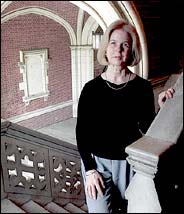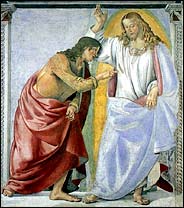| Want to send this page or a link to a friend? Click on mail at the top of this window. |
| Posted June 18, 2003 |
The Heresy That Saved a Skeptic |
By DINITIA SMITH |
PRINCETON, N.J. — On a bright Sunday in February 1982, a grief-stricken Elaine Pagels, jogging in running shorts, found herself stopping at the Church of the Heavenly Rest in Manhattan. Two days before, she had learned that her son Mark, 18 months, had pulmonary hypertension and was dying. It had been a long time since Ms. Pagels, a renowned biblical scholar whose 1979 book "The Gnostic Gospels" won the National Book and the National Book Critics Circle Awards, had been to church.
She had never been able to embrace the certainties of Christianity, the virgin birth, the physical resurrection of Jesus, as literal events. But now she found herself intensely drawn in by the prayers and the choir's soaring voices.
What was it, she wondered, that made Christianity so compelling, despite the obstacles of doctrine? The question grew more urgent. In 1987, Mark, 6, died. Then, 15 months later, Ms. Pagels's husband, Heinz, a physicist, was killed in a climbing accident, leaving her with their two other children, Sarah, 2, and David, 3 months, both of whom the couple had adopted.
Now, Ms. Pagels says, she has found the answer to her quest by writing a book, "Beyond Belief: The Secret Gospel of Thomas." It is a study of one of the Gnostic gospels, early Christian texts written around the time of the New Testament and regarded as heretical. Ms. Pagels's book, clearly written, lyrical but deeply scholarly, is a surprise hit. Out just a month, it is moving up the best-seller list, and Random House has had to reprint it three times, with 108,000 copies now in print.
Ms. Pagels, a professor of religion at Princeton University, was interviewed last week in her large stucco house surrounded by lush gardens. "I am interested in how the Gnostic gospels change our view of what we know as Christianity," she said, "in how Christianity became what it became."
She is 59, with a small face and blond hair, and was dressed in tailored black pants and blue jacket. She spoke softly, precisely: "There are some kinds of Christianity that insist you have to believe literally in doctrine. The Gnostic gospels open out the complexity and multiplicity of approaches to this. If you think the story of the virgin birth is mistranslated, for instance, it doesn't mean you have to throw out the whole thing."
 |
| Jill C. Becker for The New York Times |
| Elaine Pagels |
The gospel of Thomas is one of over 50 texts discovered by an Egyptian peasant in 1945 buried in a jar near the village of Nad Hammadi. Some were burned for fuel. The 52 that survived include poems, prayers and gospels (meaning "good news"), translated from Greek into Coptic, an African language. The texts' true authors are unknown.
One, the gospel of Thomas, claims to give Jesus' secret teachings. It includes some traditions thought to date from A.D. 50 to 100, and perhaps earlier than the official Gospels of the New Testament, Matthew, Mark, Luke and John. Another, the Testimony of Truth, recounts the story of the Garden of Eden from the point of view of the serpent, who is not evil but a principle of divine wisdom.
Among the most revolutionary findings in the Gnostic texts were the varying interpretations of Jesus' rising. Some say that the Resurrection was not a physical event but a symbol of how Christ's spirit could be felt in the present.
Early Christians were subject to unimaginable persecutions, and church fathers believed that for Christianity to survive, there had to be a unified belief system, Ms. Pagels said. Some time around A.D. 180, Bishop Irenaeus of Lyons denounced all gospels but Matthew, Mark, Luke and John as heretical, "an abyss of madness and of blasphemy."
About 50 years after Constantine's conversion early in the fourth century, the New Testament became Christianity's official text.
The name Thomas, in Aramaic, means "twin." Thomas may have proselytized in India, where Thomas Christians still worship today. Ms. Pagels chose to study Thomas because although his gospel is very similar to the accepted Gospels, there are crucial differences, especially between his and John's.
The Gospel of John calls Thomas "doubting Thomas." According to John, Thomas does not believe that Jesus has physically risen. Jesus appears and rebukes Thomas for being faithless. But when Thomas touches Jesus' wounds, he capitulates. "My Lord and my God," he cries. Ms. Pagels interprets this as John's attempt to discredit Thomas's teachings that differ from his own.
"John has a low view of human beings," Ms. Pagels said, pointing out that for John, Jesus is a divine being who descended to earth. But in Thomas's gospel, she continued, Jesus' light is shared by all humanity.
Thomas "has a high view of the rest of mankind," Ms. Pagels said. "That's the crucial difference in Thomas."
In John, Jesus alone offers access to God. But, she said, "Thomas's Jesus directs each disciple to discover the light within himself." Thomas writes, "Within a person of light, there is light." Thus, for Ms. Pagel, Thomas gives more autonomy to the individual.
During the eight years it took to write the book, Ms. Pagels said, she began to find Thomas illuminated her own experience. "Belief was not an issue anymore," she said. "It offered a different version of faith. The other versions had become univocal. We read the Gospels as if they all say the same thing."
 |
CGFA |
| "Doubling Thomas" by Luca Signorelli (1441-1523) shows Thomas confirming the Resurrection of Jesus by touching his wounds. |
Ms. Pagels is often asked if she is a Christian. She worships in the tradition of Christianity, she said, because "that was the language of my culture," and attends an Episcopal church. "I love this tradition," she said, "but I also love many of the voices that are considered heretical."
She was born into a family that was culturally Protestant but non-practicing. Her father, William McKinley Hiesey, was a plant biologist at Stanford University. "There was no acknowledgment of a spiritual dimension of life except as delusion," she said.
As a teenager, Ms. Pagels joined an evangelical church. She was drawn by the music, she said, and was curious. It was also a rebellion, and she eventually stopped going.
She graduated from Stanford, where she was a classmate of the poet Sharon Olds, who remembers her: "She had great dreams. I would dream about people getting murdered and people counting hamburgers, and she would dream about hillsides and beautiful woods."
From early on, Ms. Pagels wanted to be a dancer. She studied briefly with the Martha Graham Company in New York but realized, she said, that "I was not going to be fabulous." So she enrolled as a Ph.D. student in the religion department at Harvard and learned Coptic.
She married Heinz R. Pagels in 1969 and was hired as a Barnard professor. "The Gnostic Gospels" was Ms. Pagel's first mainstream book. After its publication she won a MacArthur Fellowship and wrote "Adam, Eve and the Serpent" (1988), in which she asserted that the traditional Christian attitudes toward sexuality emphasizing abstinence were not part of its origins but were developed in the fourth century by St. Augustine, who promoted the doctrine of original sin.
Then came the catastrophes of her son's and husband's deaths. Ms. Pagels went into isolation, taking her two young children with her. She was "like an animal licking her wounds," said her friend, Wendy Doniger, a professor of the history of relgions at the University of Chicago. She wrestled with the connection between the tragedies and her work. Often, people believe that a tragedy is their own fault, or that God has done it to them. "She did not find that comforting," Ms. Doniger said. "The truth behind those books that came after the deaths is that what happened to her is a morally inexplicable set of accidents."
In 1991, Ms. Pagels moved to Princeton. She published "The Origin of Satan" in 1995, arguing that Satan in the Hebrew Bible was not evil but an obstructing angel, God's interlocutor. She said Satan became the personification of evil partly as a result of early Christian efforts to demonize adversaries, including Jews.
A friend had introduced Ms. Pagels to Kent Greenawalt, a professor at Columbia Law School and an expert on constitutional law. Each had been devotedly married for two decades and widowed in the same year. In 1995, the two married and combined families (Mr. Greenawalt has three children). The years since, Ms. Pagels said, have brought her ever increasing happiness.
And what was the answer to the question she posed at the beginning of her new book? What is it about Christianity that she loves? She struggled for words. "The hints and glimpses of spiritual possibility," she said, "of the mystery that shines through our experience."
"Wordsworth does it better in `Tintern Abbey,' " Ms. Pagels said, quoting from the poem:
While with an eye made quiet by the power
Of harmony, and the deep power of joy,
We see into the life of things.
Copyright 2003 The New York Times Company. Reprinted from The New York Times, Arts & Ideas, of June 14, 2003.
| Wehaitians.com, the scholarly journal of democracy and human rights |
| More from wehaitians.com |